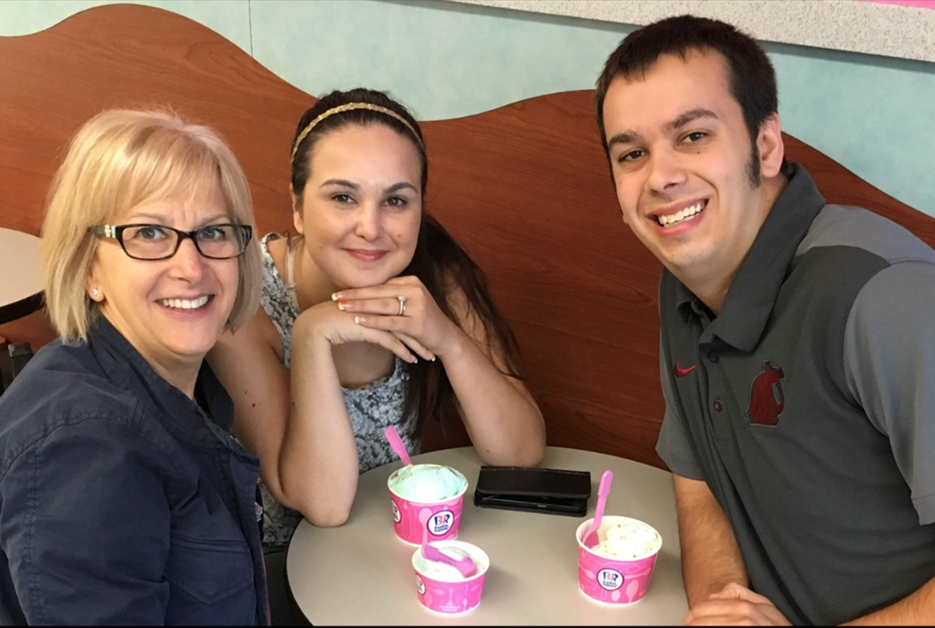Finding strength at Good Samaritan inpatient rehab


Pictured far right, 19-year-old Stephanie Cochrane enjoyed ballet and tap dancing prior to her accident.
On June 22, 1982, 19-year-old Stephanie Cochrane’s life turned upside down. The dancer, gymnast, skier and competitive swimmer was parasailing off her family’s boat on Lake Tapps when a gust of wind blew the parasail wing into a tree. Stephanie slammed sideways into a cement bulkhead.
“I was rushed to MultiCare Tacoma General Hospital, where they discovered I had a spinal cord injury, which was a compression fracture of my L1 and L2 vertebrae,” she recalls. “I was paralyzed at that point from the waist down, and doctors weren’t sure what kind of recovery I would have.”
After extensive surgery, Stephanie moved to Good Samaritan Inpatient Regional Rehabilitation Center. At the center — whose state-of-the-art-care is funded, in part, by generous donors — she faced the reality of her situation for the first time.
Getting by with help from family, friends and Good Samaritan staff
“Until I went to Good Samaritan, I didn’t realize I wasn’t going to fully recover,” Stephanie explains. “I thought once I go to the hospital, I’ll pop right back to how I was. But it was at the center I realized I had some serious, permanent damage. I needed to learn how I was going to deal, physically and emotionally, with these changes in my future.”
Fortunately, Stephanie found herself surrounded by a support network to help her cope and heal. With her family living in Sumner, they frequently made the trip to Puyallup for visits in between her three to five hours of intensive therapy per day plus meals and rest.
Stephanie also met Elaine, another person with paraplegia, and two people with quadriplegia; all were close to Stephanie’s age and had experienced accidents around the same time.
“They called us the four musketeers,” Stephanie says. “It was cool to have that experience and go through rehab with them. They were a safety net.”
Her care team was also by her side throughout her rehabilitation journey, acclimating Stephanie to life outside the center’s walls and showing her how to greet her new world with strength and grit. They also taught her to be her own advocate, a lesson that remains 40 years later.
The rehabilitation center and Stephanie 40 years later
Around the same time Stephanie was in the care of Good Samaritan, the new rehabilitation center opened its doors.
“I remember seeing the beautiful new rooms and all the exercise equipment,” Stephanie says. “I was actually one of the first people down there.”


Stephanie no longer uses a wheelchair and walks with a cane. She works out at the gym and swims regularly and has worked at Nordstrom for 35 years.
Physicians, nurses and therapists continue to provide high-intensity rehab services, considering clients like Stephanie’s needs, goals and situation. Conditions treated include long-haul COVID-19, stroke and neurological conditions, along with spinal cord, brain and major trauma injuries. In 2021, the center had an 89 percent community discharge rate, demonstrating how Good Samaritan helps people gain independence in self-care and mobility.
Inpatient treatment often requires a high level of physician intervention, 24-hour rehab nursing care and a combination of therapies, all of which may not be covered by health insurance.
At this year’s Corks & Crush wine tasting and fundraising event, community generosity will bridge the gaps for those facing rehabilitation without full coverage. On May 21, 2022, the community will come together at the Washington State Fair Events Center for an evening of fine wine, gourmet dining and lively auctions in the name of therapy services: inpatient rehab in East Pierce County and Mary Bridge Good Samaritan Children’s Therapy Unit.
“Corks & Crush is a great opportunity to improve the lives of others,” Stephanie shares. “You never know how you may be connected to someone who needs these services. If I didn’t have the rehabilitation center as a resource, I don’t know where I’d be right now.”
And as a mom to a 27- and 29-year-old, she’s grateful the center remains close by — ready to serve her, her family, friends and community for years to come.
You can help therapy patients and clients like Stephanie live their best lives. Support the cause by attending Corks & Crush on May 21 or giving now.




